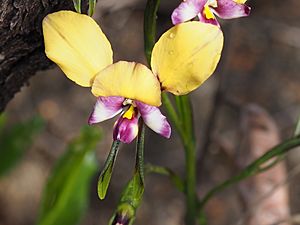Beautiful donkey orchid facts for kids
Quick facts for kids Beautiful donkey orchid |
|
|---|---|
 |
|
| Diuris pulchella in the Mount Burdett Nature Reserve | |
| Scientific classification | |
| Genus: |
Diuris
|
| Species: |
pulchella
|
The Diuris pulchella, also known as the beautiful donkey orchid, is a special type of orchid flower. It grows only in the south-eastern part of Western Australia, which means it is endemic to that area. This beautiful plant has two or three leaves at its base. It can grow up to five bright yellow and mauve flowers. People have described these flowers as "exquisite," "spectacular," and "attractive" because they are so pretty. You can find the beautiful donkey orchid growing in shallow soil on rocky areas called granite outcrops, especially near the town of Esperance.
What Does It Look Like?
The beautiful donkey orchid is a plant that grows from a special underground storage part, like a small potato. It lives for many years. It has two or three leaves that are long and thin, like a line or a spear. Each leaf is about 100 to 200 mm (4 to 8 inches) long and 6 to 10 mm (0.2 to 0.4 inches) wide. The leaves are folded lengthwise.
This orchid can grow up to five bright yellow flowers. These flowers often have markings of mauve, green, and white. Each flower is about 20 to 40 mm (0.8 to 1.6 inches) long and 20 to 30 mm (0.8 to 1.2 inches) wide. The flowers grow on a stem that can be 300 to 500 mm (12 to 20 inches) tall.
Let's look at the parts of the flower:
- The dorsal sepal is a leaf-like part at the top of the flower. It points forward at its base and then curves upwards. It looks like an egg or a kidney shape. It is about 9 to 14 mm (0.4 to 0.6 inches) long and 10 to 13 mm (0.4 to 0.5 inches) wide.
- The lateral sepals are two other leaf-like parts that hang downwards. They are long and thin, green with purplish marks. They are about 15 to 22 mm (0.6 to 0.9 inches) long and about 3 mm (0.1 inches) wide.
- The petals are the main showy parts of the flower. They stand mostly upright. The main part of the petal is egg-shaped, about 15 to 18 mm (0.6 to 0.7 inches) long and 9 to 11 mm (0.4 to 0.4 inches) wide. They sit on a greenish-mauve stalk about 5 to 7 mm (0.2 to 0.3 inches) long.
- The labellum is a special lip-like petal. It is about 9 to 10 mm (0.4 inches) long and has three parts, called lobes. The middle lobe is shaped like a wedge or is almost round. It is about 7 to 10 mm (0.3 to 0.4 inches) wide. The two side lobes are about 8 to 10 mm (0.3 to 0.4 inches) long and 3 to 4 mm (0.1 to 0.2 inches) wide.
- There is a single yellow, ridge-like bump called a callus near the base of the labellum. It covers about one-third of the labellum's length.
These beautiful orchids usually bloom in August and September.
How It Got Its Name
The scientific name for the beautiful donkey orchid, Diuris pulchella, was first officially described in 1991. It was named by a botanist (a plant scientist) named David Jones. He found a specimen (a sample of the plant) in the Mount Ney Nature Reserve. The description was then published in a magazine called Australian Orchid Review.
The second part of its scientific name, pulchella, comes from a Latin word, pulcher, which means "beautiful." The ending "-ella" makes it a smaller version, so pulchella means "beautiful little." This name was chosen because of its "highly colourful and attractive flowers." Other people have also described these flowers as "exquisite" or "spectacular."
Where It Lives
The beautiful donkey orchid usually grows in shallow soil. You can find it on and around large rock formations called granite outcrops. It lives in a specific area of Western Australia. This area stretches between the towns of Salmon Gums, Esperance, and Balladonia. This region includes parts of the Coolgardie, Esperance Plains, and Mallee areas.
Is It Safe?
The Western Australian Government's Department of Environment and Conservation has looked at the Diuris pulchella. They have classified it as "not threatened." This means that, for now, there are enough of these beautiful orchids, and they are not in danger of disappearing.

